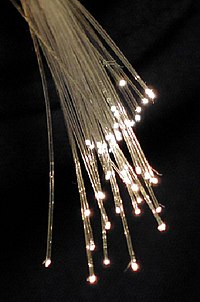
Photo from wikipedia
In this experimental study of the nonlinear loss mechanism between traveling localized excitation and the underlying extended normal mode spectrum for a 1D lattice, three types of cyclic, electric, nonlinear… Click to show full abstract
In this experimental study of the nonlinear loss mechanism between traveling localized excitation and the underlying extended normal mode spectrum for a 1D lattice, three types of cyclic, electric, nonlinear transmission lines (NLTLs) are used. They are nonlinear capacitive, inductive, and capacitive+inductive NLTLs. To maintain a robust, steady-state traveling intrinsic localized mode (ILM), a traveling wave driver is used. The ILM loses energy because of a resonance between it and the extended NLTL modes. A wake field excitation is detected directly from ILM velocity experiments by the decrease in ILM speed and by the observation of the wake. Its properties are quantified via a two-dimensional Fourier map in the frequency-wavenumber domain, determined from the measured spatial-time voltage pattern. Simulations support and extend these experimental findings. We find for the capacitive+inductive NLTL configuration, when the two nonlinear terms are theoretically balanced, the wake excitation is calculated to become very small, giving rise to supertransmission over an extended driving frequency range.
Journal Title: Chaos
Year Published: 2022
Link to full text (if available)
Share on Social Media: Sign Up to like & get
recommendations!